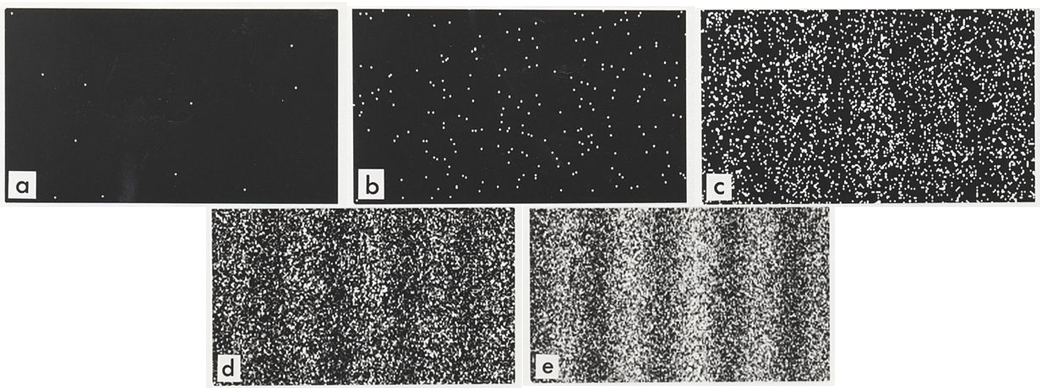Variations on the Double Slit Experiment
 Electron buildup over time, demonstrating an interference pattern created by the interference of individual particles. (Tonomura)
Electron buildup over time, demonstrating an interference pattern created by the interference of individual particles. (Tonomura)
The Interference of Individual Particles Variation
The first variation on the Double Slit experiment doesn't seem too exciting at first. The principle is that one replaces the light source that Young used, with an emitter that can fire single particles or electrons from a point source, then watch them build up on a detector. What makes this so fascinating is that as the particles build up, an interference pattern emerges just as before. One way to interpret this is that the particles are traveling through the both slits simultaneously as a wave, and interfering with themselves. Then when they reach the emitter the wave function "breaks down" and they resolve as a single particle again, at one of the possible locations on the wave. It is as if the wave correlates to a probability distribution where larger peaks present a more likely location for the particle to ultimately end up in, and in the meantime the particle (as a wave) is simultaneously in every possible position at once. This idea that particles fundamentally have some wave-like, and some particle-like properties is fundamental to our current understanding of quantum mechanics, and is generally known as the particle-wave duality.
The Which Way Variation
Obviously one of the next things scientists wanted to do was observe which slit the particle was going through in order to see how it could possibly be creating an interference pattern. Originally proposed as a thought experiment, feasable methods for testing this have only been around since the 1970s. The principle is that one must peform the experiment with electrons, and place a form of detector in front of one of the slits to determine which slit the electron went through. The problem with this experiment is that it is impossible to detect which slit the electron went through without destroying the coherence of the wave. In other words, the pattern created on the screen is due to the fact that as the wave passes through both slits, it's amplitude and period are constant and predictible. Any measurement systems to determine which slit intrinsically affect the coherence and thereby the final result on the screen. This experiment has, however, still been used to show many different aspects of complementarity, including the complementary nature of wave and particle properties, meaning that they cannot both be measured or observed simultaneously.
The Delayed Choice Variation
This is a variation on a variation, if you will. First proposed in 1978 by John Wheeler, the principle behind this variation is the same as that behind the Which Way variation, but rather than place the detector in front of the slits, it is placed between the slits and the screen, to determine which slit a particle passed through. The experiment shows that when which way information is collected after the particles have passed through the slits, it causes the particles to seemingly retroactively alter how they passed through the slits. Rather than an interference pattern appearing on the screen, all that are observed are two clumps, one corresponding to each slit, suggesting that the particles were acting as particles and not waves when they passed through the slits, even though the measurement took place after that decision should have already been made.
The Quantum Eraser Variation
The quantum eraser variation is one of probably the most confusing, but also the most interesting, variation on the Double Slit experiment. For this variation, photons, rather than other particles, will be used. The principle is that after the photons pass through the slits, they pass through a non-linear crystal. Non-linear crystals are unique because they are able to split a single photon into an entangled photon pair with a combined energy equal to that of the original photon, preserving the coherence of the photons in the process. When the photons pass through this non-linear crystal, an entangled pair of photons are created which are each half of the energy of the original photon. One of them continues heading towards the screen, while the other heads off to a detector. By setting up a crystal for each slit, which way information can be resolved from one half of the pair of photons. When those detectors are enabled, however, the photons create a simple pile on the screen with no interference pattern. Extracting the which way information from the one photon in the pair seems to prevent the other photon from acting like a wave, even if the photon that reaches the detectors does so after its pair hits the screen. Even stranger is that if the information from the detectors is scrambled, say by introducing more detectors and using 50% silver mirrors (so that half of photons are reflected and half pass through) to randomize which detectors receive which photons from which slits, the interference pattern returns. Nothing has changed about the experiment except that the information about which slit the photon passed through can no longer be correlated to the detector, but how would the photons know that? Additionally, implementing a delayed-choice element such that the decision of whether or not to measure the which way information was made after the particles had already passed through the slits is completely irrelevent to the results, as is whether the measurements or scrambling of the information are done before or after the pairs have hit the screen. This variation has deeply increased the understanding of quantum mechanics, demonstrating many of the effects of quantum entanglement as well as complementarity.